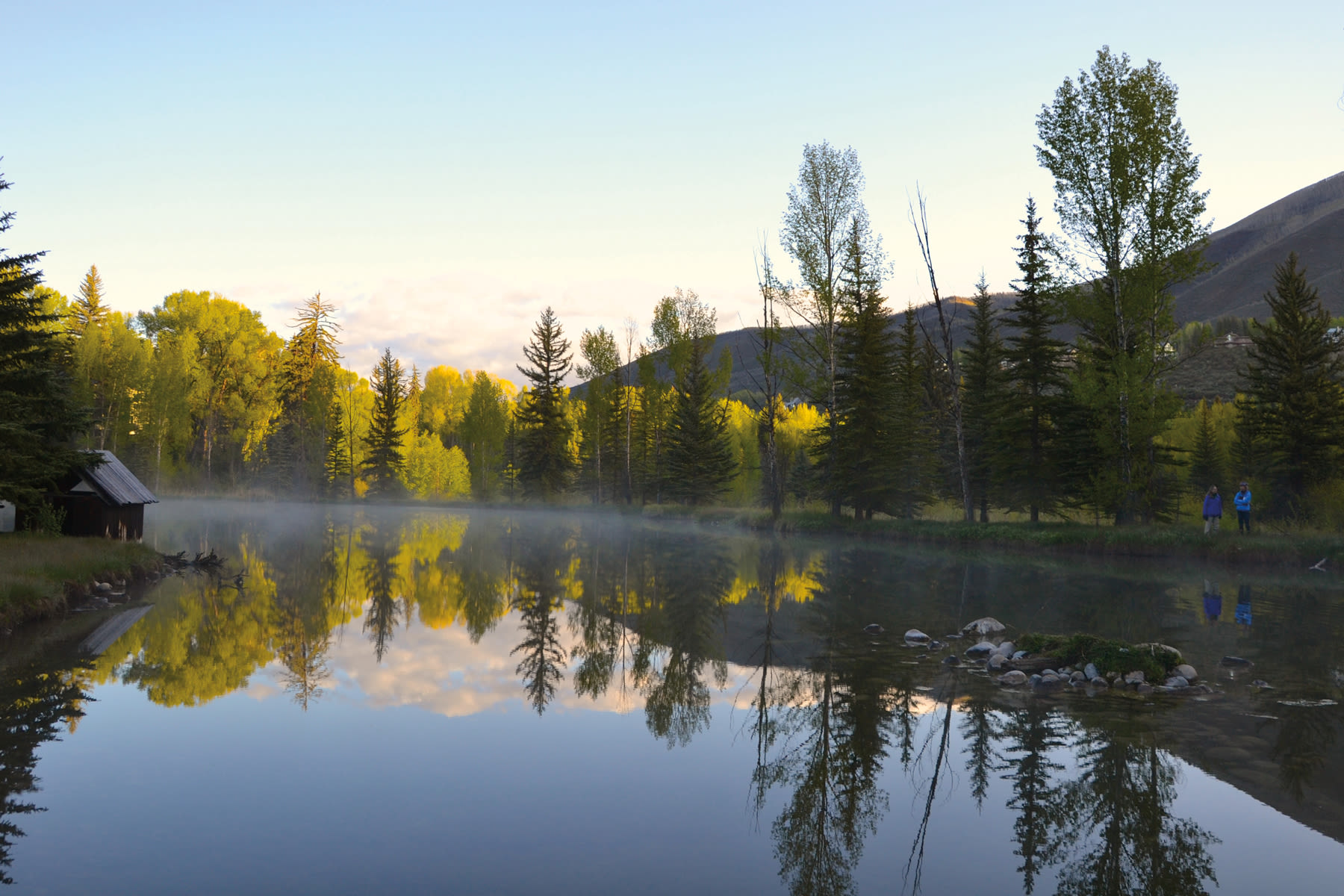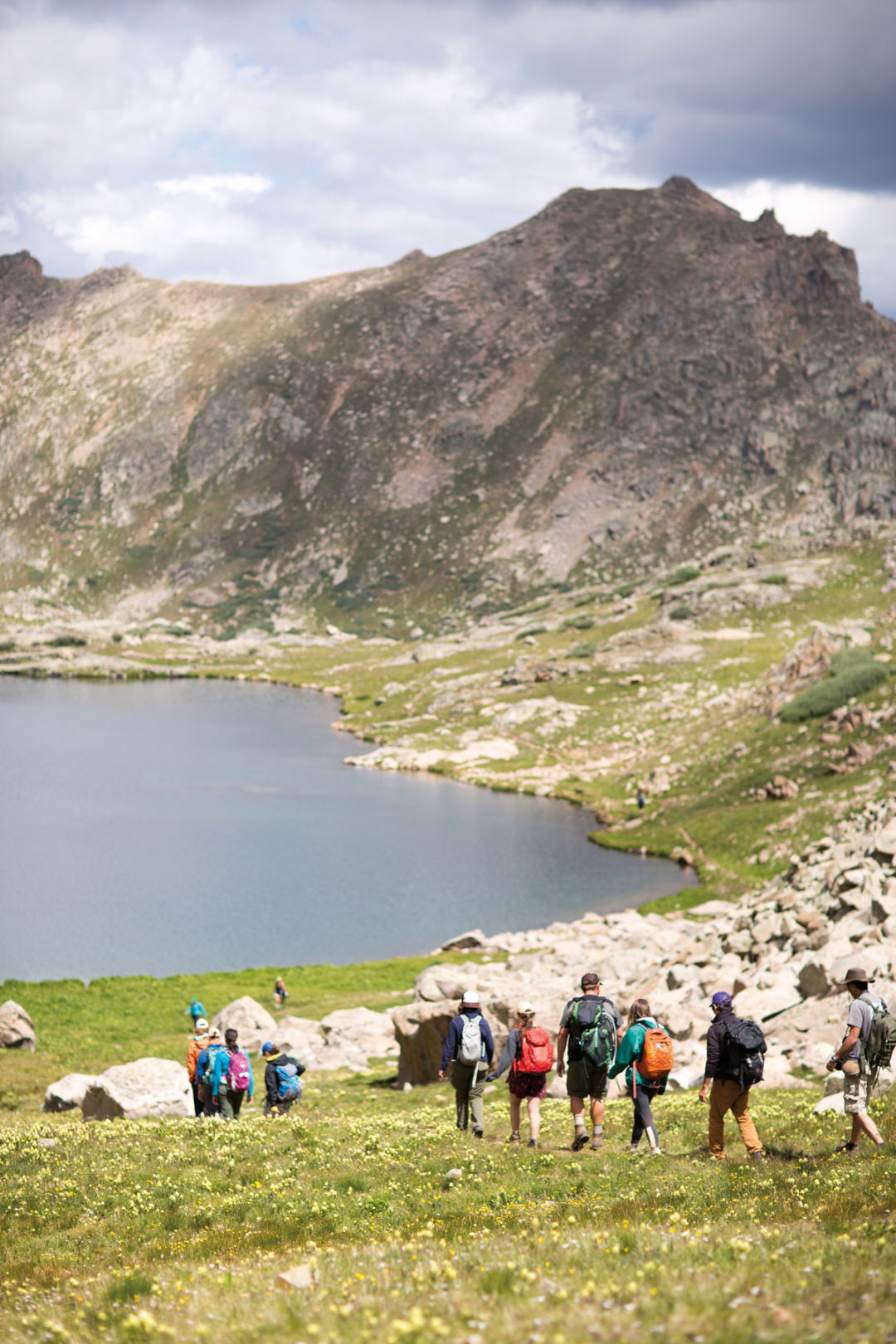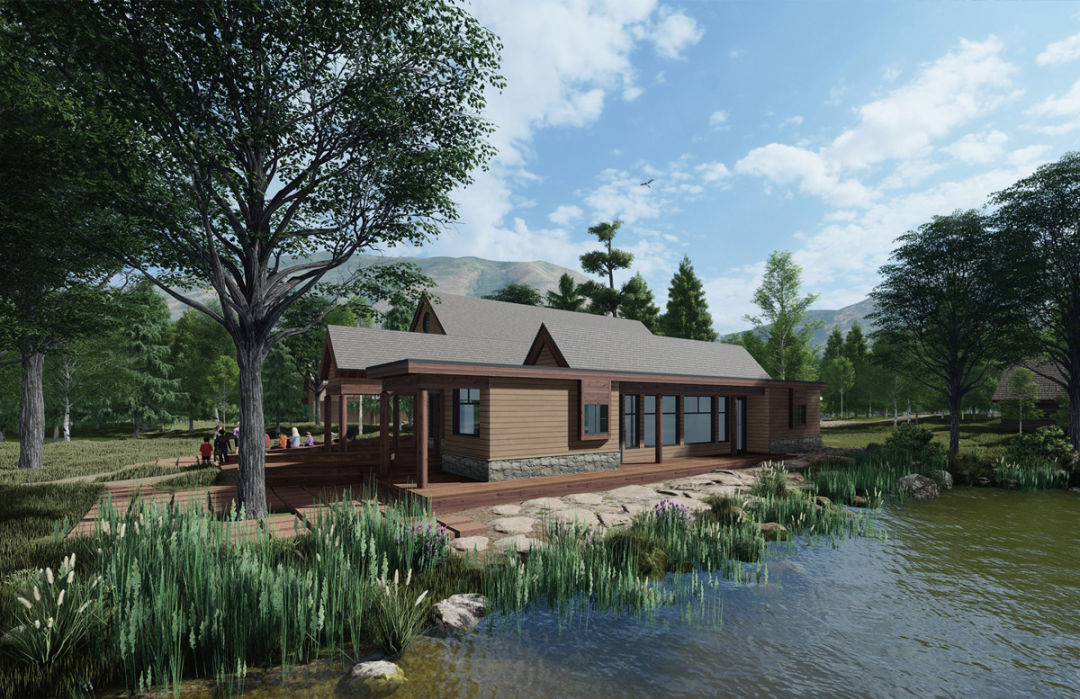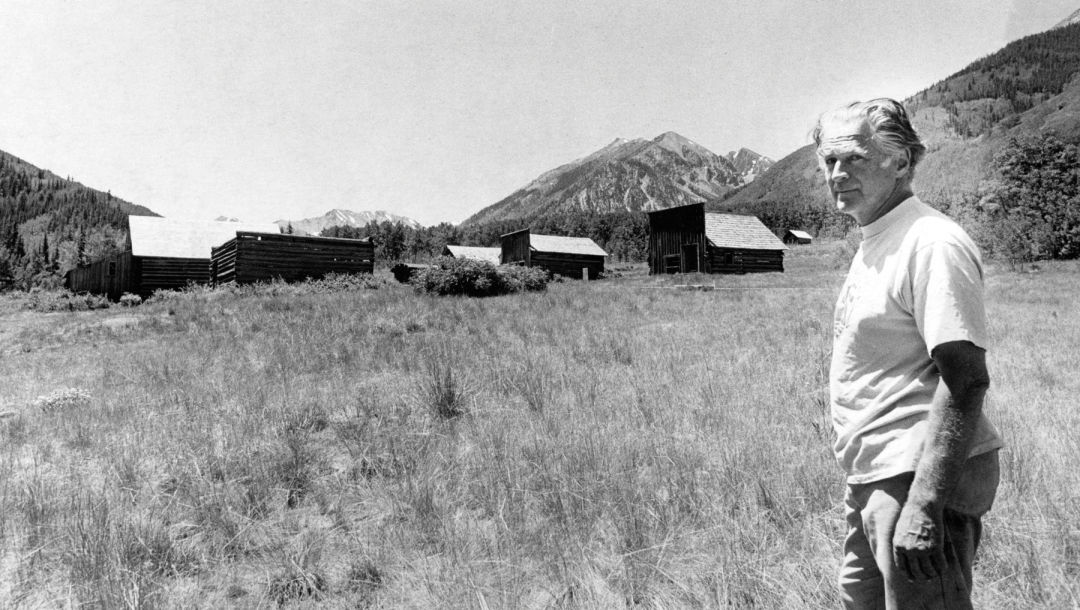
ACES Celebrates Its Golden Anniversary
Image above: The Hallam Lake Nature Preserve at sunrise. Photograph courtesy ACES
What does it mean to be rich?
In Aspen, that can be a loaded question. For some it may simply mean having the financial wherewithal to visit and enjoy one of the most expensive playgrounds in the world. For others the notion of being rich is rooted in the appreciation of nature and community, with a connection to place that goes far beyond money or any other type of materialism.
Since 1969, when Elizabeth Paepcke donated her 22-acre property in Aspen’s West End for a nature center and preserve, the Aspen Center for Environmental Studies, or ACES, has taught the broader philosophy of wealth to residents and visitors alike. Grounded in the “Aspen Idea” of harmony between mind, body, and spirit, the nonprofit has long spread the notion, far beyond the Roaring Fork Valley, that a caring, ethical relationship between people and nature is one of life’s essential components.
“Rich is what fills you up with all the things that you need—sunshine, fresh air, healthy food, hearing the birds,” says Jim Kravitz, ACES’ naturalist programs director. “It’s the truest sense of belonging. Everyone who comes to Aspen wants to meet locals. What’s a local? I’ve known people who’ve lived here only three years but are so local because they’ve worked to know the rhythms of a place and then share that with others.”
Fifty years ago, Paepcke recruited botanist Stuart Mace, legendary founder of the Toklat lodge (see sidebar), and Aspen High School science teacher Bob Lewis as the first trustees of her fledgling organization.
Mace, says his son Kent, thought even 40 years ago that humans were living out of balance with nature. “He felt that our priorities were not the correct ones and that we should stop dominating nature with man’s daily actions,” notes Kent. “He believed from the depth of his soul that there was spirit in nature.” In a 1974 PBS television interview with Bill Moyers, Stuart Mace said, “You can’t appreciate your fellow man until you appreciate nature; without that you can’t feel any wholeness.”
Today, that mission lives on through ACES’ myriad experiential outdoor- and classroom-based environmental science programs for children and adults. From its base at Hallam Lake, that original pocket of wilderness in the center of Aspen donated by Paepcke, ACES has grown to encompass a regenerative agriculture farm, Rock Bottom Ranch near Basalt; Tomorrow’s Voices, an environmental stewardship program for high school students; a naturalist program that has educated nearly 450 college graduates to date (and set them free to share their learnings in the world); the Catto Center at Toklat; and an initiative that provides restoration and research for Colorado’s forest ecology.
Additional programs range from stargazing, storytelling, and birding to snowshoe and hiking tours, farm-to-table dinners, and community presentations by nationally known speakers. Along the way, the nonprofit has taught thousands of students about environmental sciences in classrooms throughout the valley, now reaching to Rifle, Silt, and Battlement Mesa.
It’s notable, Kent observes, that ACES has lasted 50 years as an advocate for the earth. “To see an organization that has stood up for nature and education, helping our youth to know the natural process, is just incredible,” he says. “Stuart would be absolutely thrilled.”

ACES educators on a training trip in the Aspen backcountry
Image: Courtesy ACES
Even More Education, More Outreach
This summer, in celebration of its golden anniversary, ACES kicks off a $10 million capital campaign for a host of improvements and program expansions, including renovations to the Hallam Lake visitor center and habitat enhancements at the lake, infrastructure upgrades and increased sustainable agriculture education and production at Rock Bottom Ranch, and an augmented curriculum outreach for underserved communities that are hungry to learn about their own natural surroundings. Of that, $5 million is designated for the Catto Center at Toklat, the pristine wilderness retreat center located in the Castle Creek Valley.
Starting in 1975, Jody and Tom Cardamone served as ACES’ first co-directors and naturalists (and guides, educators, farmers, and toilet cleaners), with Tom taking over as executive director in 1990. The couple lived on the Hallam Lake property in an old horse barn built in 1906, on the site where today’s visitor center sits. They led the organization for 36 years, until 2012, when current executive director Chris Lane took the reins.
“ACES is continually building on the shoulders of those who have come before and influenced it,” says Tom Cardamone. “The staff is a wonderfully self-selecting group; they teach science but model empathy and stewardship.”
The Cardamones were at the helm when ACES purchased Toklat in 2004—with financial help from Jessica Hobby Catto and her husband, Henry—from the family of Ted Ryan, who had given the Mace family a lifetime lease. It had been Stuart Mace’s wish that ACES would take over Toklat and preserve the land in the Castle Creek Valley.
“Stuart taught us to appreciate the quieter parts of this valley that get overlooked,” says the Cattos’ daughter Isa, who grew up taking wildflower hikes at Toklat. “I feel tremendous gratitude; each and every one of us are avid conservationists. Mother, in particular, understood something magical about that valley and didn’t want to see it developed.”
The capital campaign for the Catto Center at Toklat will preserve and enhance its role as a deep ecology retreat center, offering programming for both adults and youth. Besides enabling much-needed repairs on the building itself and a new residency cabin to house scientists, artists, writers, and other thinkers, the funds will be used to create new wilderness retreat programs, forest bathing experiences, and overnight classes. A newly donated 10-acre parcel across Castle Creek Road from Toklat, called the Riverdance property, will grow ACES’ ability to connect youth from vastly different backgrounds to nature through hands-on, environmental education experiences.
“The center is a place where people eat, meet, and connect over nature, around bonfires and walking barefoot on a path,” says Lane. “If you’re an urban person, this is unique. Toklat connects people to nature in almost a spiritual way—the stars, the sunsets, the fall aspen leaves.”
The goal isn’t to increase the number of people at Toklat, he adds, but to make the experience more immersive and intimate. With no cell or internet service, Toklat stands as one of the few remaining places in the valley where people can go to just be quiet and think. “There is a demand, whether you are rich or poor, for nature,” says Lane. “We want to renovate Toklat but keep the historical funkiness and not lose its amazing magic.”

A rendering of planned enhancements to the Hallam Lake visitor center
Image: rendering courtesy ACES
Building on What Works
Over the next 50 years, ACES’ primary objective will be to continue to carry on Mace’s legacy of spreading the importance of environmental protection, believes Lane. “Nature unites all of us,” he says. “That is the thing ACES has to carry forward, to continue our ability to affect generations and have them change the world.”
Since Lane has been at the helm, he’s had two overarching missions for ACES: to enhance and build upon the “great work” that others have done before him and to broaden the organization’s strengths. The latter category includes expanded school education programs, a Forest Health Index that now tracks 38 watersheds across Colorado, and efforts to make Rock Bottom Ranch a nationwide destination for regenerative agriculture. “We want ACES to be the humble environmental conscience of this city, forever,” he says. “We don’t want to lose our roots. But we also aspire to affect things statewide and even on a national level.”
Certainly, the time is right for the nonprofit to increase its voice as many think we’ve hit a point of environmental crisis. For humans to remain on this planet, says Kent Mace, our thinking needs to shift, immediately. “We have forgotten our place and are poisoning our world,” he notes, echoing his father’s wisdom. “That is what Toklat and ACES continue to stand up for in a loving, heartfelt way.”
In standing up for the idea of a vibrant, dynamic community that is in tune with nature, ACES is apt to help Aspen stay “rich” for decades to come.

Stuart Mace at Ashcroft in 1970
Toklat Turns 70
In 1949, Aspenites Walter and Elizabeth Paepcke—always looking for the best and brightest to realize their vision of reviving and transforming the town—recruited Stuart and Isabel Mace to move their growing family and dogsled operation here from Boulder. Stuart Mace, a botanist (and the former director of the Arctic dogsled team at Camp Hale during World War II), had been seduced by the Castle Creek Valley near the ghost town of Ashcroft, seeing in its mountain wilderness an opportunity to build a lodge, restaurant, and dogsled touring operation that could host visitors in a living classroom while educating them about the land’s rich ecological diversity.
He christened the lodge “Toklat,” an Inuit word meaning “glacial mountain headwaters,” and lived on the property with his family—eventually five sons and a daughter—until his death in 1993. Isabel continued to live at Toklat, running the restaurant and an art gallery with daughter Lynne until 2004, when ACES fulfilled Stuart’s lifelong wish and acquired the property.
Along the way, thousands of visitors immersed themselves in Toklat’s unspoiled nature through hikes, home-cooked meals, dogsled tours, and evenings around the bonfire. Additional people became familiar with the setting through the television series Sergeant Preston of the Yukon, which was filmed in the area and featured Mace’s sled dogs.
Many previous guests (or their children) return to the Catto Center at Toklat even today, expressing wonderment at how much is the same and recalling their initial visits as defining, life-altering experiences.
Art has always been a part of Toklat as well, with the on-site gallery showcasing paintings, photography, drawings, sculptures, and handmade furniture from local artists, including Stuart Mace himself. In the late 1980s, Mace introduced handwoven Zapotec rugs to Toklat after meeting Elena Gonzalez Ruiz during a trip to Teotitlán, Mexico. Since then, Gonzalez Ruiz has been a long-standing artist-in-residence, coming to the Castle Creek Valley each summer to teach the art of weaving and dyeing as her indigenous community has sustainably practiced it for generations.
“Stuart’s passion was to expose people to the magic and majesty of nature, through hikes and art and natural food—back when it wasn’t cool to be into natural food,” says his son Kent Mace. “Toklat to him was a place to drop your ego and put Mother Nature first and be in balance. My parents were completely dedicated to this idea.”
Isabel Mace, says Lynne, was the rock upon which Stuart relied. “I don’t know any enigmatic, charismatic man that doesn’t have a supportive wife in the background,” she says. “My parents had a lot to teach the Aspen community and the world. Their legacy still could.”
Says Jim Kravitz, naturalist programs director, of the Maces and Toklat, “They are a part of ACES, and we are a part of them.”

Arin Trook
Image: Chris Cohen/Courtesy ACES
ACES’ Arin Trook: In Memoriam
This past winter, the Aspen community suffered a huge loss when ACES’ education director, Arin Trook, passed away in an avalanche. A beloved educator and an inspiring force for good, he dedicated his life to teaching the importance of environmental justice and social responsibility and created at ACES a rich curriculum to educate youth in the Roaring Fork Valley and beyond.
Trook, a Stanford graduate with a master’s degree in education from the University of California, Berkeley, was passionate about the outdoors and infusing environmental education into both schools and the larger community. He led the expansion of ACES’ ecology and field programs to a wider range of students—as far away as Parachute and Silt—and from early childhood through high school, pioneering new ways for kids and teachers to connect to the natural world in their own backyard.
“In my 24 years with ACES, I’ve met a lot of environmental educators,” says Jim Kravitz, naturalist programs director. “Arin was the best I ever knew. He was someone that made other people feel rich, through song, through story, through his bouncy nature. And he had the substance, the education, to back it all up.”
Trook’s impact on children and adults ran deep—as an educator, yoga instructor, storyteller, friend, husband, and father—as evidenced by the hundreds of people who attended his memorial service and by those from Aspen and beyond who contributed to a GoFundMe memorial fund. This summer, ACES is naming an apprenticeship program in Trook’s honor for high school students interested in environmental science and education careers.
ACES Throughout the Years
1971
Board of directors meets for first time; Hallam Lake fenced to keep out dogs and fishermen
1974
Environmental education programs begin in Aspen schools
1978
ACES Naturalist Program launches with four summer naturalists
1982
Injured golden eagle brought to Hallam Lake. She turns into ACES’ longest-serving educator until her death in May 2019 at the age of 38
1987
Partnerships formed with Aspen Skiing Company and US Forest Service
1988
Hallam Lake Visitor Center and Bird of Prey House built
1991
Twelve summer naturalists hired
1993–94
Winter Naturalist Programs developed in partnership with SkiCo, Forest Service, and Colorado Division of Wildlife
1999
ACES purchases Rock Bottom Ranch, expanding its holdings to the midvalley
2012–13
Environmental education program expands to Basalt and Carbondale schools
2015
Partnership with Pitkin County Open Space and Trails provides education programs in and near the North Star Nature Preserve
2017
Staff housing completed at Rock Bottom Ranch
2018
Environmental education expands to schools in New Castle, Silt, Battlement Mesa, and Parachute
2019
New, energy-efficient staff housing project started in Carbondale














































